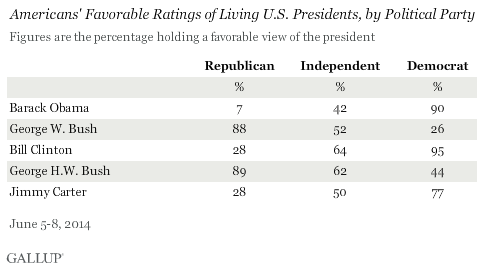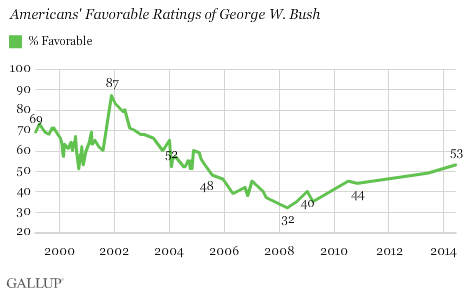PRINCETON, NJ -- Americans view each of the four former living presidents more positively than negatively, while giving Bill Clinton and George H.W. Bush higher favorable ratings than George W. Bush and Jimmy Carter. Current President Barack Obama has a net-negative favorable rating.

The younger Bush's current favorable rating is likely lower than other former presidents' ratings because his term, marked by job approval ratings well below 40% during his final two years in office, is the freshest in Americans' minds.
Though Carter left office with similarly poor job approval ratings, his lower favorable ratings today are mostly attributable to one in six Americans not having an opinion of him. That includes 36% of those younger than 30, all of whom were born after Carter left office in 1981. The only other time Gallup measured opinions of Carter with this question format, in 2007, 69% rated him favorably, 27% unfavorably, and 4% had no opinion.
The data are based on a June 5-8, 2014, Gallup poll and represent Americans' current opinions of the four former living presidents and the current president. The elder Bush recently turned 90, and Carter will do so later this year, making them among the longest living former presidents.
In addition to these personal favorable ratings, Gallup has previously measured Americans' views of how each president's term will be judged by history and retrospective job approval ratings of former presidents. Clinton and the elder Bush also fared better than Carter and the younger Bush on those metrics.
Partisanship Drags Down Rating of Current President
Americans typically rate presidents more positively after they leave office, so Obama's relatively worse standing than his predecessors is not surprising. However, the current poll represents Obama's worst favorable rating to date.
The public likely views the incumbent president in more strongly partisan terms than former presidents, given the chief executive's role in negotiating the prevailing political and policy disputes of the day. Past presidents largely stay away from those contentious matters but still serve a public but largely ceremonial role, often using their high profile for charitable work.
As evidence of the more partisan evaluations of the current commander in chief, Republicans give Obama a much lower favorable rating (7%) than the two former Democratic presidents, Clinton and Carter (both 28%).
Still, partisanship is a major factor in how Americans view ex-presidents, with former presidents rated much more highly by supporters of their own party than by supporters of the other party.

George W. Bush Back Above 50%
George W. Bush appears to be reaping the public opinion benefits of being a former president. His current 53% favorable rating marks the first time it has been above the majority level since 2005, early in his second term as president.

Bush began his first term in office in 2001 as a relatively popular figure with a 64% favorable rating. After the Sept. 11 terrorist attacks that year, his favorability surged to 87%. His ratings stayed high, above 60%, until 2004, the year he sought re-election.
A difficult second term -- dominated by the ongoing war in Iraq and including domestic difficulties such as the response to Hurricane Katrina, rising gas prices, and an economic recession -- contributed to a steep drop in Bush's personal popularity. By April 2008, 32% of Americans had a favorable opinion of Bush and 66% had an unfavorable one. After leaving office with a slightly higher 40% favorability score, his rating improved to the mid-40s in 2010 and the high 40s in 2013 before the most recent increase.
Bush's favorable rating has improved by nearly the same amount among all party groups since he left office, up 11 percentage points among Republicans (77% to 88%), 15 points among independents (37% to 52%), and 15 points among Democrats (11% to 26%).
Implications
Americans are largely forgiving of former presidents, as each of the four living ex-presidents had times in office when they had job approval ratings below 40%, if not 30%. Clinton and the elder Bush recovered and left office with majority job approval, while Carter and the younger Bush stayed unpopular through the end of their terms.
Despite the different circumstances of those presidents, a majority of Americans now have mostly positive opinions of all four, although they do rate the elder Bush and Clinton more favorably than they do the younger Bush and Carter.
Obama's current favorable ratings are the worst of his presidency, and they are worse than former presidents' ratings. No matter how popular or unpopular he is when he leaves office in a little more than two years, Americans' views of Obama personally should improve once he becomes a former president.
Survey Methods
Results for this Gallup poll are based on telephone interviews conducted June 5-8, 2014, with a random sample of 1,027 adults, aged 18 and older, living in all 50 U.S. states and the District of Columbia.
For results based on the total sample of national adults, the margin of sampling error is ±4 percentage points at the 95% confidence level.
Interviews are conducted with respondents on landline telephones and cellular phones, with interviews conducted in Spanish for respondents who are primarily Spanish-speaking. Each sample of national adults includes a minimum quota of 50% cellphone respondents and 50% landline respondents, with additional minimum quotas by time zone within region. Landline and cellular telephone numbers are selected using random-digit-dial methods. Landline respondents are chosen at random within each household on the basis of which member had the most recent birthday.
Samples are weighted to correct for unequal selection probability, nonresponse, and double coverage of landline and cell users in the two sampling frames. They are also weighted to match the national demographics of gender, age, race, Hispanic ethnicity, education, region, population density, and phone status (cellphone only/landline only/both, and cellphone mostly). Demographic weighting targets are based on the most recent Current Population Survey figures for the aged 18 and older U.S. population. Phone status targets are based on the most recent National Health Interview Survey. Population density targets are based on the most recent U.S. census. All reported margins of sampling error include the computed design effects for weighting.
In addition to sampling error, question wording and practical difficulties in conducting surveys can introduce error or bias into the findings of public opinion polls.
For more details on Gallup's polling methodology, visit www.gallup.com.
